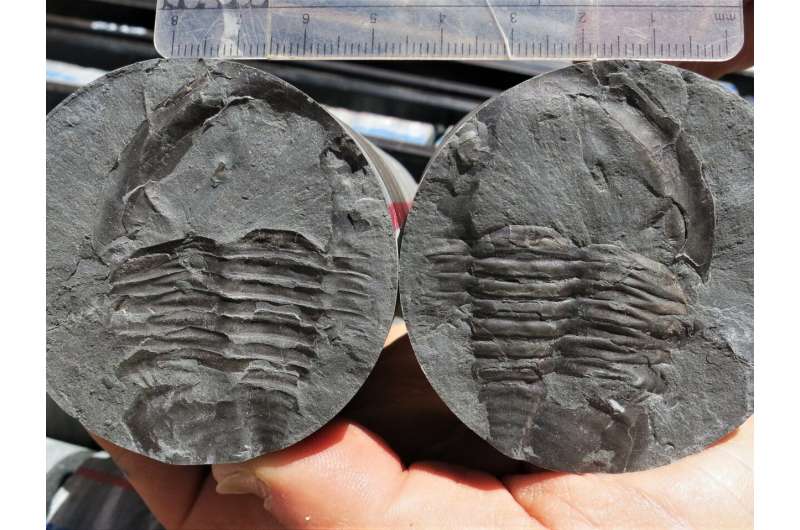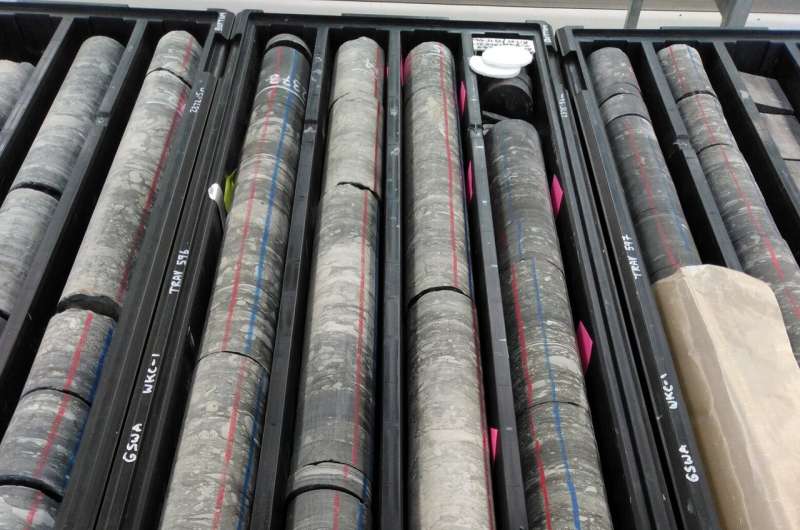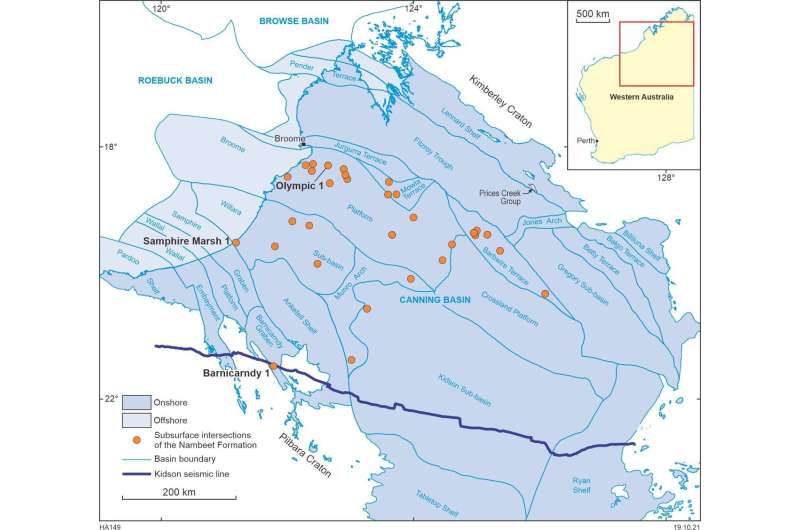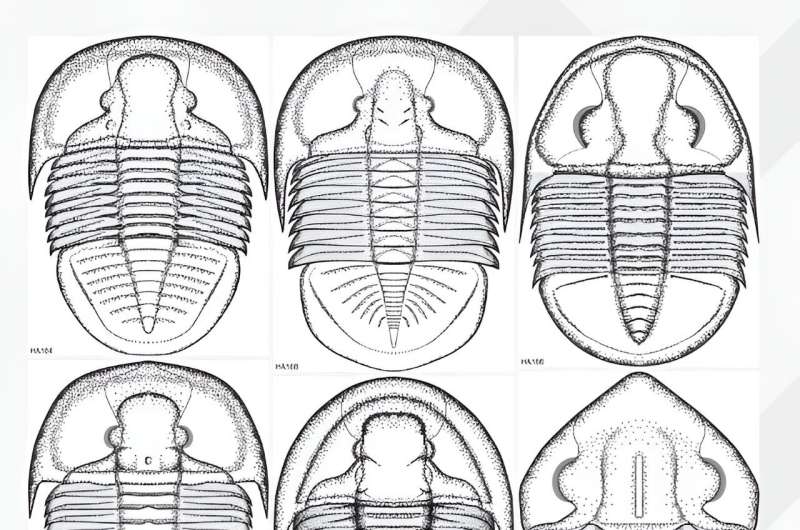This article has been reviewed according to Science X's editorial process and policies. Editors have highlighted the following attributes while ensuring the content's credibility:
fact-checked
proofread
Six new species of Western Australian trilobites discovered

Six new species of trilobites have been found deep underground in the Canning Basin of Western Australia. Dr. Patrick Smith at the Australian Museum and Heidi Allen from Geological Survey of WA tell us how this discovery has reshaped our understanding of ancient life and geological time in the region.
The discovery of a new species of trilobite (extinct crustacean-like marine animals) has the potential to challenge our perceptions of time and space—so it is groundbreaking when scientists discover multiple new species. Resulting from a stratigraphic drilling program by the Geological Survey of Western Australia and Geoscience Australia, the researchers published the discovery of six new trilobite species. in Alcheringa: An Australasian Journal of Palaeontology.
What is stratigraphic drilling and why do we do it?
Stratigraphic drilling involves a vertical cylindrical section of rock (core) being extracted from the ground using a special cutting rig. For this study, the purpose of the core was to explore how this sequence of rock in the southern Canning Basin may relate to those farther north.
Previously, it was reported that the core contained a diverse fossil assemblage which were all marine animals, including brachiopods (shelled animals), graptolites (colonial animals), bivalves (clams), nautiloids (shelled squid), gastropods (snails), ostracods (seed-sized crustaceans) and trace fossils. The majority of these fossils (including the new trilobites) came from a kilometer thick sequence of rocks called the Nambeet Formation, which starts approximately 1.3 km down in the core.

Why were the results unique?
The discovery of trilobites at such a time and place is not too surprising. However, what was unexpected was the diversity and abundance within this core.
Normally, cored rocks only have a small area for fossils to be captured so usually there's little chance of hitting a fossil, let alone something useful for identification. Yet, in this sequence trilobites were so abundant that almost every single layer of rock contained a fragment. In fact, the rock is entirely made of trilobites in places, stacked one on top of each other, like a pack of playing cards!
Among the six new species of trilobite identified were a few highly unusual forms. For example, one species had a subtriangular tail with an extraordinarily long backwards pointing spine ornamented with blade-like serrations on either side. This feature appears to be characteristic of the genus Sanbernardaspis and is not found in other closely related trilobites.
Given the tail spines resemblance to a fearsome sword, it seemed fitting to name the species after something equally medieval. Therefore, we called it Sanbernardaspis excalibur, after the mythical sword of King Arthur Excalibur that was pulled from a stone (in reference to the species having been extracted from a similar rocky tomb).

The dense layering of the trilobites meant that we could segment the core into different zones, each with its own characteristic species. The study defined these as:
- Apatokephalus sp.–Veeversaspis jelli Assemblage (2,177.50–2,382.94 m depth and dated to the latest Tremadocian, approximately 479 to 477 million years ago),
- Asaphellus trinodosus Assemblage (2,030.07–2,177.52 m depth and dated to the latest Tremadocian, approximately 479 to 477 million years ago), and
- Asaphellus zheni Assemblage (1,595.83–2,001.88 m depth and dated to the middle Floian, 474 to 471 million years ago).
The core had previously been dated using microfossils called conodonts (hagfish-like animals) and pollen from the earliest land plants. These suggested a broad "Early Ordovician" (479 to 470 million years old) age for the rocks.
This was accurate, but, not very precise. However, using the trilobites zones we were able to get much more specific age for the layers of rock within the core. In particular, they could place the boundary between the Tremadocian to Floian stages to exactly 2001.88 m in the core. It also revealed an intriguing time gap between some of the rocks of the Asaphellus trinodosus and Asaphellus zheni assemblages.

Why is this so important?
This discovery has been vital in providing a greater precision for dating rocks in this part of Western Australia. Scientists can now more closely compare related geological cores and rock exposures in areas, like Broome and the Emanuel Ranges.
Preliminary work (still ongoing) suggests a close relationship with these areas and it has also permitted correlations with rocks further afield in areas such as central Australia, Victoria, western Queensland, and even as far as northern China and South Korea.
This project highlights the value of collaboration between the Geological Survey of Western Australia, Geoscience Australia and the Australian Museum. These institutions are at the frontiers of exploration and geoscience, making essential discoveries about Australia's hidden geological past.
They are also applying it to a green energy future by providing the raw data necessary for activities such as prospectively searching for helium or hydrogen gas, geothermal energy and potential for CO2 sequestration, all of which are essential for Australia's move into a green energy future.
More information: Patrick M. Smith et al, Early Ordovician trilobites from Barnicarndy 1 stratigraphic well of the southern Canning Basin, Western Australia, Alcheringa: An Australasian Journal of Palaeontology (2023). DOI: 10.1080/03115518.2023.2226194
Preliminary paleontological summary of Barnicarndy 1 stratigraphic well, Canning Basin. Geological Survey of Western Australia, Palaeontology Report. dmpbookshop.eruditetechnologie … ell-canning-basin.do
Yong Yi Zhen et al, Early Ordovician conodonts from Barnicarndy 1 stratigraphic well of the Southern Canning Basin, Western Australia, Alcheringa: An Australasian Journal of Palaeontology (2022). DOI: 10.1080/03115518.2021.2017481
Provided by Australian Museum





















